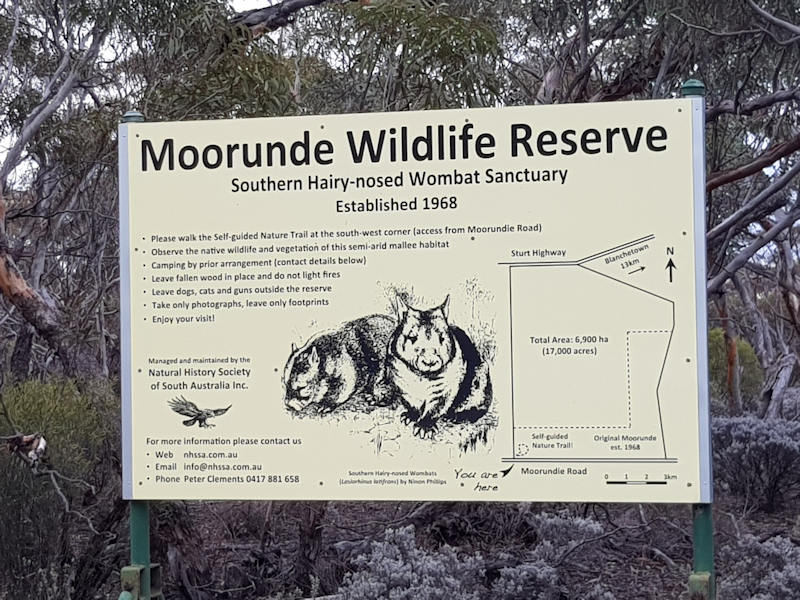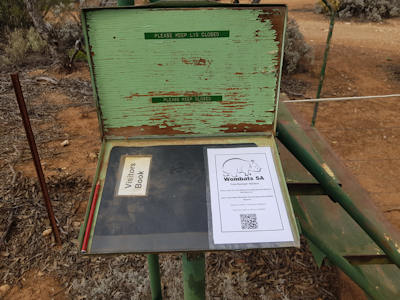Welcome to Moorunde Wildlife Reserve, home to more than 2,000 Southern Hairy-nosed Wombats.

Moorunde Wildlife Reserve has a very interesting nature trail which although only 1.3kms long, provides a great chance to immerse yourself in the mallee experience and see the workings of some wombat burrows. We have put together a printed booklet, packed with useful information, which can be found at the beginning of the trail (or download the brochure). There is a lot of detail in the printed booklet which can be found at the beginning of the trail. Wombats SA thanks Konica Minolta for generously printing this Moorunde Nature Trail Guide Book.
The map below is supplied in the booklet to help you get the most from this activity and to enjoy their habitat. NOTE: The point markers are now attached to large rocks near the Trail.
If you would like to download a copy of the Guide Book before you visit, please click on the link.

Map – Moorunde Nature Trail Guide Book
This land was purchased by Wombats SA (formerly the Natural History Society of South Australia) to protect the habitat of Southern Hairy-nosed Wombats. As you walk the trail you will see how well the native plants and animals have adapted to the semi-arid environment. Where there is no damaging interference from people, our plants and animals can thrive in a healthy ecosystem.
Wombats are mostly nocturnal. They spend most of the day underground in burrows, sometimes emerging in the late afternoon to sit at their burrow entrance. While you may not see the wombats themselves, you will see where they live. You will also learn how plants and animals survive in this semi-arid habitat.
The sign below offers more information about the site. The original inhabitants of this area the Nganguraku people called wombats Muyruyri. You are advised to ngopun (walk quietly) on the yarli (track) and remember to take muthen (water) and a kulindjeri (hat) with you.

As you move around the trail, there will be plenty to photograph and, if you are lucky enough to spot a wombat or other wildlife, please add your photo to the Wombats SA Facebook page and tell us where you saw it and what it was doing.
Together, our native plants and animals thrive in Australia’s dry environment.
You have seen some of the ways that our plants and animals make the most of limited resources in the arid environment. All of the aspects you have seen combine to provide a healthy ecosystem.
1. The duricrust traps nutrients in the soil so that plants can grow.
2. The plants provide food and shelter for many animals, birds and insects.
3. Many birds and insects in turn pollinate the plants, enabling them to reproduce. In this way, our plants and animals thrive together in a balanced ecosystem.
Thriving habitats such as that here at Moorunde are needed to support our Southern Hairy-nosed Wombats and the many thousands of plants, animals, birds and insects that contribute to a healthy environment. You can help by donating on our website to contribute to the maintenance of this and our other wildlife reserves within SA. See our Donation Page.
If you would like to download a copy of the Guide Book before you visit, please click on the link.
Locating the Moorunde Nature Trail
Smoothest route: Drive South from Sturt Highway on Sperling Road until you get to the Moorundie Road Crossing. Turn East down Moorundie Road.
Alternative route: Drive East from Halfway House Road on Moorundie Road – a bit rougher in parts.
After the Moorunde Road/Sperling Road Crossing, travel East until you reach a gate across the road. The image below shows you what to expect. Make sure you close the gate after you have gone through if it’s open.

Walking down the road after closing the gate you will come across a stile which goes over the fence into the Reserve

Once over the stile you will find the start of the trail a few metres in. Here you can take a brochure from the holder, which will help you interpret what the trail is telling you.

Each point on the Trail is marked with a large rock and may have other name markers, etc.

At the end of the trail you will be back at the stile and there is another stand there which contains the Visitor’s book and perhaps some free stickers. We appreciate your comments about your visit and a ranger looks at them weekly. Then all that is left is for you to climb the stile, return to your vehicle after making sure the gate is shut.

We hoped you enjoyed your visit to Moorunde Nature Trail. If you would like to help out on the Reserve, please go to https://wombatssa.org.au/support-us/visitor-volunteer-weekends/ and drop us a line.
